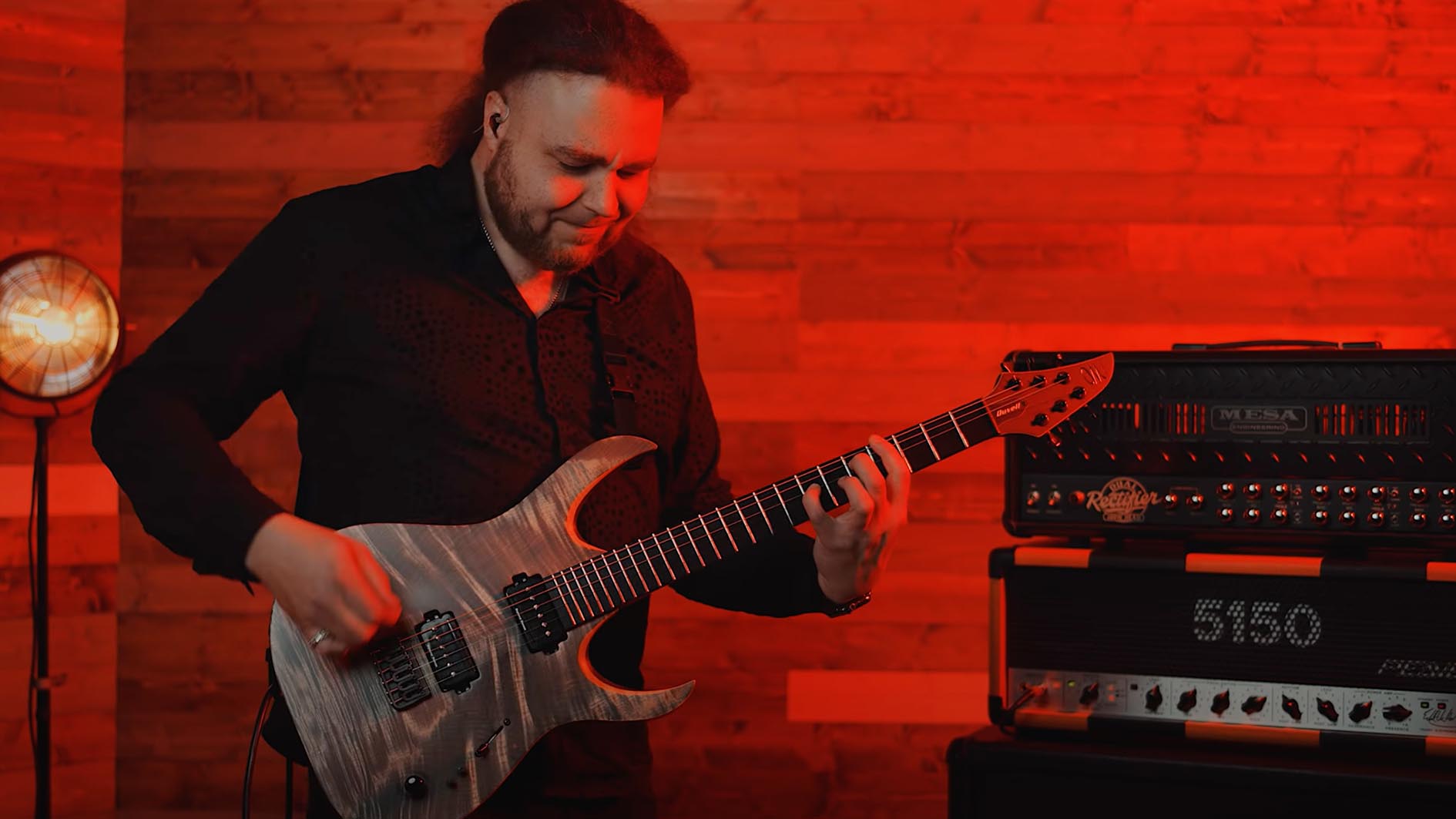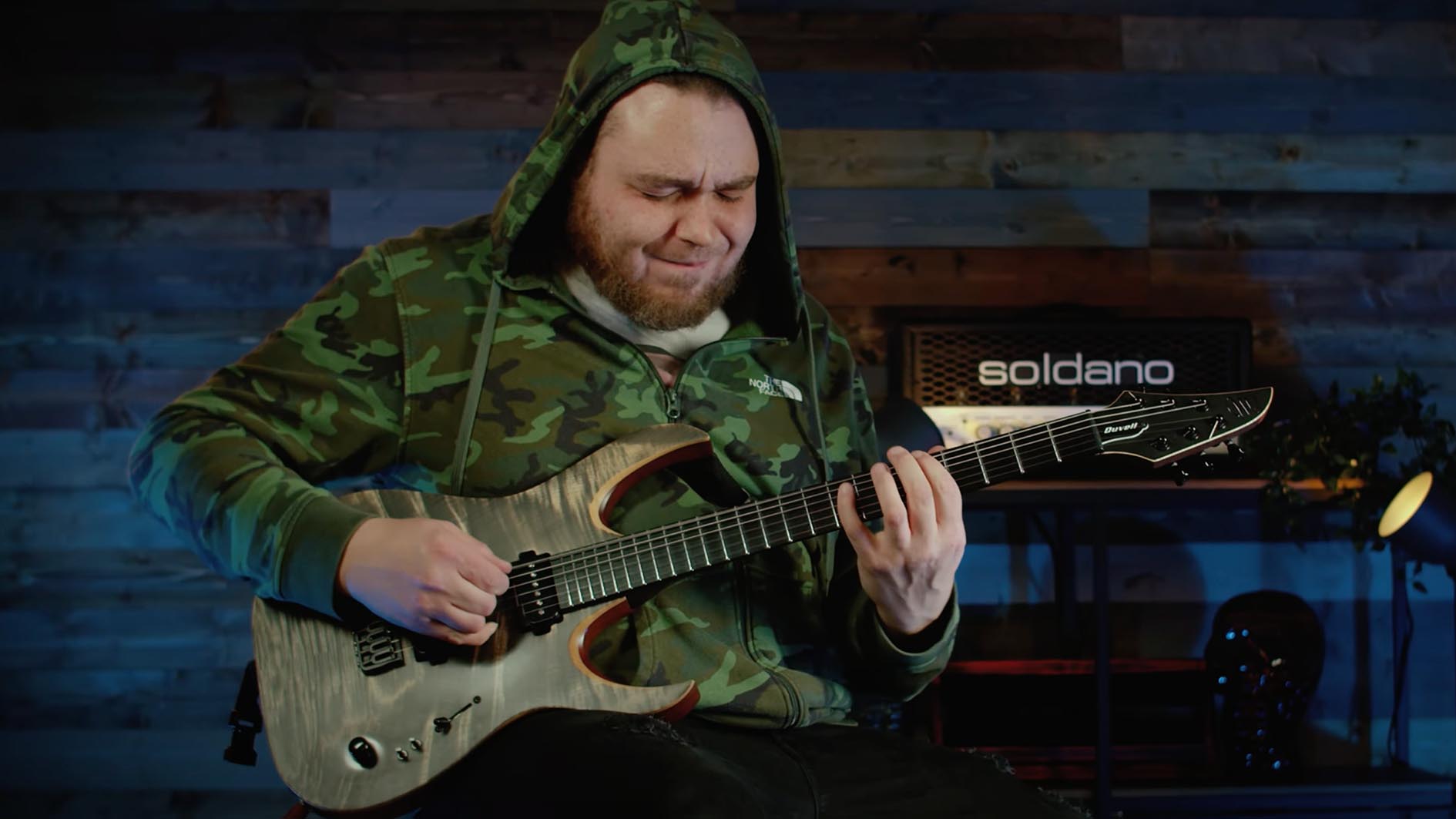John Browne on how Doom composer Mick Gordon ended up on the new Monuments album – and why they're moving forward as a one-guitar band
The prog-metal mainstay discusses the making of devastating new record In Stasis and why nothing cuts through like his Mayones Qatsis

Though Monuments guitarist John Browne has connected with Guitar World to get into the rich, tectonic-plate shifting aggression of Monuments’ latest wrecker, In Stasis, the seven-string adventurist can’t help but also put the shine on a couple of his favourite players.
Through his RIFFHARD YouTube channel, the London, UK-based guitarist recently recorded playthroughs and lesson-plans from the likes of Jack Gardiner and Tom Quayle; he praises both legato-loving players as masterful improvisers.
When asked of his own proficiency with winging leads, the guitarist explains that Monuments’ dedication to the almighty djent had initially come out of physical necessity.
“I used to enjoy [improvising] when I was just beginning my guitar journey, but I had to change my style completely because I’d developed psoriasis on my hands,” Browne explains. “When it came to bends and vibrato, I found that it was tearing my fingers to pieces.”
While Browne had briefly considered putting down his guitar for good, the rhythmic pound of djent music opened up his mind to new percussive possibilities.
He explains: “I’d just heard Meshuggah at the time, and was like, ‘I think I can get away with playing something like this, versus trying to shred.’ That’s why my playing developed in this direction. It wasn’t because I wanted to stop that [lead] style, it’s because my hands wouldn’t allow me to do it. If anything, that ailment actually helped me.”
It’s hard to argue with that line of reasoning, considering the all-out devastation the guitarist delivers on In Stasis. That’s not to say Browne’s fretting hand isn’t lithe with quick-pivot, low-string pull-offs on pieces like False Providence – despite the in-amber allusions of In Stasis’ title, the guitarist puts his signature Mayones Qatsis to work.
Get The Pick Newsletter
All the latest guitar news, interviews, lessons, reviews, deals and more, direct to your inbox!
Elsewhere, he’s prone to pivot from percussively punishing fretboard crawls towards darkly melodic chord work (Cardinal Red); he dynamically conjures up a series of jazzy 9ths and 11ths through a brief acoustic reprieve on its otherwise crushing, closer, The Cimmerian.
On a molecular level, In Stasis also presents a newly evolved Monuments. Drummer Mike Malyan returned to the fold for his first Monuments album since 2014’s The Amanuensis, and the record is the first to feature vocalist Andy Cizek, who linked up with the band in 2019.
Australian videogame composer Mick Gordon also teamed-up with the quartet – which also features bassist Adam Swan – to add assorted production flourishes. Though the composer drilled damning nine-string heaviness into his highly regarded Doom soundtracks, his work through In Stasis is more synth-forward and sculptural.
Speaking with Guitar World, Browne further detailed his rhythmic drive, and what it was like to work with composer Gordon on Monuments’ most dynamic doomscape.
Can you get into your general philosophy towards rhythms in Monuments, where you put a bigger focus on low technique over the high lead work?
The note choice can be changed, but if you’ve not got a good rhythm to support that choice then it’s just notes
“When it comes to music, the end goal is, ‘Can you feel it through your bones?’ I grew up in a pretty diverse musical household. My mom had a record collection of everything from Earth Wind and Fire, to Pink Floyd, Herbie Hancock, and Stevie Wonder; on my dad’s side, it was stuff like Tchaikovsky and Chopin. I always enjoyed stuff that’s more rhythmic than melodic.
“I think that’s the thing that it comes down to the most. The note choice can be changed, but if you’ve not got a good rhythm to support that choice then it’s just notes. Take a band like Meshuggah: there are rhythms they do that are absolutely incredible [but] they only have one note in them.
There are these moments like that on In Stasis, too. One of the most memorably heavy moments on the record is on Makeshift Harmony, where you’re punching hard with this straight-forward, staccato, octave-hopping riff. On the other side of that, though, what’s the techiest part on this record?
“It’s funny you mention Makeshift Harmony, because that’s actually one of the hardest songs to play on the record. That part you’re talking about is actually the breather [laughs]. The rest of the song is kind of crazy; that’s where I can relax for a bit.
“If every part of a song is just chaos, you don’t have that dynamic to make heavy parts sound [truly] heavy [because] it’s all at that one level. Often, we’ll counteract those really complex bits with something simpler, because it gives the listener an opportunity to not have all this information coming at them at once.
“The middle riff of False Providence sounds easy but it’s one of the harder parts on the record because Andy [Cizek, vocalist] decided to pitch-shift some parts in pre-production, and I had to translate that to guitar.
“Now I’ve got a chord that went from really simple to a spider chord, and I’m transitioning into something like that quite quickly. There are a couple bits where its uncomfortable [to play], but the main focus of this record was just writing stuff that felt good.”
How does the idea of false providence translate to your journey on guitar, or music-making? Are there things that you thought were important about your style and technique when you were younger that you’ve since realized weren’t, after all?
“The main thought behind the song is that we go through stages in our lives where we believe in something so strongly, and then we change our minds. Sometimes that can completely shatter everything about us.
“As far as it could relate to guitar-playing, I was so focused on lead playing when I was a kid. At one point I thought I was going to have to give up the instrument [in part due to psoriasis], but then I found something different that I ended up preferring. I guess the message is just because you had to have you mind changed, it’s not the end.”
How familiar were you with Mick Gordon’s scoring work for the Doom franchise and other games before you connected with him for In Stasis?
Any time there’s a weird noise, synths, strings, or anything that doesn’t resemble a guitar, bass, or an acoustic drum kit, it’s more than likely Mick Gordon
“When [Mick Gordon’s] original Doom music came out [in 2016], I was like, ‘Damn, this is absolutely incredible!’ I randomly sent him an email, and he replied within a few hours. We just started chatting from there, and got to hang out with him the last time [Monuments] played in Brisbane. We got on really well!
“He was meant to do the production work behind for the last record [2018’s Phronesis], but he got offered Doom Eternal just as we were about to start so he had to be like, ‘Sorry, can’t do it.’ I totally understood.
“When it came to this record, [Lavos] really needed something dirty. I reached out to Mick and asked if he wanted to do something on the track. A few weeks later the track was done, and it was amazing. From there I was like, ‘Do you want to do the whole album?’ [laughs]
“Any time there’s a weird noise, synths, strings, or anything that doesn’t resemble a guitar, bass, or an acoustic drum kit, it’s more than likely Mick Gordon.”

Mick didn’t play any guitar on the album?
“No guitar on this record, because he said he couldn’t play my riffs – which is a lie, because I’ve seen him play them. [laughs]”
Could you see Monuments’ music scoring a game in the future?
“Funnily enough, I was offered a game compositional job about four years ago, though it never actually went to fruition. I’d actually started writing for it; it got to the point where I signed the contract, but all of a sudden… nothing. That’s something I’ve always wanted to do [though].
This style of music lends itself to certain genres of video games quite well. That’s been proven exceptionally well by Mick, and what he did for the Doom series
“I think this style of music lends itself to certain genres of video games quite well. That’s been proven exceptionally well by Mick, and what he did for the Doom series. Any anime would benefit from this style of metal as well. Attack on Titan, if you’ve heard the theme to that, is not too far away [from Monuments].”
Are your playing your signature Mayones Qatsis on this record?
“Yup.”
What are you liking about your latest Qatsi, the 2.0?
“It has the Schaller Hannes bridge, which produces a very unique sound. That bridge is way more hi-fi sounding than something like a hipshot – which obviously sounds great as well, but the Hannes has something about it that helps with attack. You’ll find that there’s this interesting sound around the upper midrange that happens with the Hannes – it almost jumps out like an acoustic.
“It’s also the most comfortable bridge ever. That plays a pretty big part in the sound of that guitar, and obviously the Bare Knuckle Nailbomb in the bridge, which is quite a dry-sounding humbucker. I love the sound of that guitar; it just cuts through no matter what.”
What’s your acoustic setup on The Cimmerian? It’s a unique moment on the record full of jazzy, acoustic chords – maybe with a DADGAD tuning on it. What is going on there?
“We needed an acoustic guitar for this one bit, so I went to a guitar store, tried out a couple guitars, and came across this Taylor 614[ce], which sounded incredible. I was about to buy it, but a guy in my building was like, ‘I’ve got that exact guitar, you want to use it?’
“The tuning is actually DADGAD in C sharp, so it’s half a step down. There’s definitely 9ths and 11ths in there, a lot of strange chords because the tuning allows for chords you cannot play in standard. That part came about randomly, actually. I didn’t think the acoustic part was going to be [approved by the band], but everyone loved it.”
There are some significant line-up shifts to In Stasis: Mike is back on drums; it’s the first record with Andy Cizek on vocals; you’ve got Mick Gordon working on the production side of things. It’s also the first Monuments album in a while to not feature Olly Steele as your co-guitarist. Will Monuments be working as a one-guitar project from here-on?
I’m not saying that there won’t be another guitar player in the future, but for now you’ll be able to hear every mistake that I make live
“For now, it’s going to be one guitar. Most of the time me and Olly played a lot of the same parts; that helped with thickness. [Now] I’m going to be running through a very strange set-up. I’m going to be using an equivalent of a TC Electronic Mimiq through a two-amp setup, where one side has that varying pitch and delay. This is actually a setup I had to do before on a tour when Olly lost his passport – we had to leave him in Winnipeg in minus 35 Celsius [weather conditions].
“The main reason [for not finding a new guitarist] is that the four of us worked so well together on this record that we decided that – for now, anyways – we want to keep those positive vibes the way that they are.
“You know, adding someone else into the equation could be too many cooks in the kitchen. I’m not saying that there won’t be another guitar player [in the future], but for now you’ll be able to hear every mistake that I make live [laughs].”
- In Stasis is out now via Century Media Records.
Gregory Adams is a Vancouver-based arts reporter. From metal legends to emerging pop icons to the best of the basement circuit, he’s interviewed musicians across countless genres for nearly two decades, most recently with Guitar World, Bass Player, Revolver, and more – as well as through his independent newsletter, Gut Feeling. This all still blows his mind. He’s a guitar player, generally bouncing hardcore riffs off his ’52 Tele reissue and a dinged-up SG.











